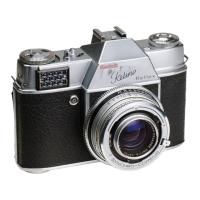THE FLASH BULB is similar to a small electric bulb. However, when current passes through it, it lights up in an
intense flash lasting usually about 1/40 to 1/60 sec. Each bulb will flash only once and has to be discarded
afterwards.
The flash bulb is inserted in a flash gun and the current of the battery fires the bulb, while a reflector fixed
behind the bulb makes sure that all the light is directed towards the subject. Most flash guns incorporate a
capacitor unit which increases the reliability of firing, even when the battery is nearly exhausted. The shutter
speed, provided it is slower than 1/30 sec. (1/60 sec. with smaller bulbs), has no effect on exposure, since the
flash is shorter than the exposure time.
Most flash bulbs are available with a clear glass bulb (for black-and-white and negative colour film and for type
F reversal colour film) or with a blue-tinted bulb (for daylight type reversal colour films). The blue bulbs can
also be used for fill-in lighting by daylight with any type of colour film.
ELECTRONIC FLASH UNITS utilize the discharge of a high-tension capacitor through a flash tube. The power is
derived from an accumulator or battery (there are also models working from the mains electricity supply). The
electronic flash outfit is rather bigger and heavier than the flash bulb outfit, its comparative light output equals
a small flash bulb and its initial cost higher.. On the other hand, anything from 10,000 to 25,000 flashes are
obtained from one tube. The flash duration is extremely short (1/700 to 1/2000 sec.) and will arrest the fastest
movements. The cost of an individual exposure is negligible.
Electronic flash is suitable for black-and-white and negative colour film and also for daylight type, reversal
colour films. It can also be used for fill-in lighting by daylight.
Above: The synchronizing settings showing also the synchronizing locking lever (top left) and the flash socket on
the camera front which accepts the flash gun lead (top centre and right). At the M setting, flash bulbs can be
synchronized with any shutter speed from 1 to 1/500 sec. (lower left). At the X setting, electronic flash will
synchronize at any speed from 1 to 1/500 sec.. but flash bulbs only to 1/30 sec. (lower centre). The V setting
controls the delayed-action release and synchronizes in the same way as the X setting (lower right).
Right: More natural-looking lighting results from "bouncing" flash
light from a light surface (i.e., a ceiling) For ease of operation, the
flash gun can be fitted into a shoe on a movable ball which itself fits
into the camera accessory shoe.
Left: The Kodablitz flash gun
for the Retina Reflex uses a
capacitor unit and a 22.5-volt miniature battery. The gun will fit either
into the accessory shoe on the camera, or on to a bracket which is
screwed into the tripod bush.
How to Use Flash

